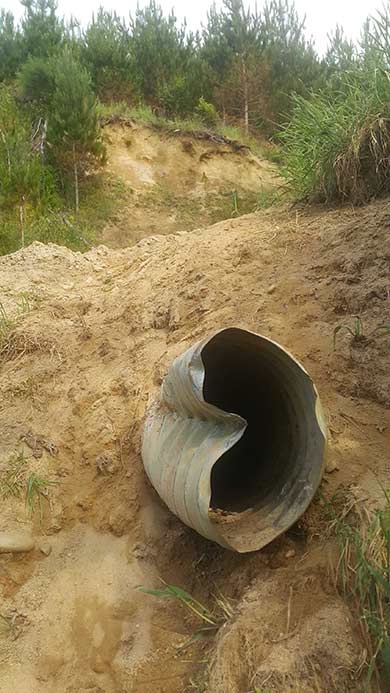Archived content: This media release was accurate on the date of publication.
Date: 12 December 2017
The kea nest, with two chicks about 2 ½ months old, was found in a disused culvert at a Tasman Pine Forests Ltd skid-site in the Motueka Valley.

The disused culvert that is home to a kea nest
Image: Corey Mosen | DOC
DOC Operations Manager Chris Golding thanked Tasman Pine Forests Ltd for suspending operations near the nest until the chicks start to fly and leave the nest in about a month.
"Work with vehicles and machinery around the nest might've damaged the nest or caused disturbance to the kea family that could be detrimental to their welfare.
"Kea is an endangered species and being able to safely raise chicks in their nests is important to increasing kea numbers."
Tasman Pine Forests Ltd Health, Safety, Environment & Risk Coordinator Rebecca Sharp said the company takes its environmental stewardship responsibilities seriously.
"The chicks were reported to us and the Kea Conservation Trust by a harvesting contractor. We're really pleased that these chicks were found in our estate, and that we can contribute to the conservation of this unique, nationally threatened species.
"This has been a great working example of the successful implementation of the Kea Guidelines for Plantation Forestry, developed by the Kea Conservation Trust and the New Zealand Forest Owners Association.
"We will retain the disused culvert that the chicks were found in, in the hope that the kea nest there again next year."
Kea Conservation Trust Conflict Co-ordinator Andrea Goodman said many forestry sites were in areas where there are kea and the Kea Guidelines for Plantation Forestry included advice for preventing kea damage to forestry equipment and for protecting kea.
"Kea are inquisitive and social birds and, because of this, they interact with people and property," said Ms Goodman said.
"The guidelines include ways for forestry companies to discourage kea from hanging around harvest sites and for protecting equipment if they are around.
"It's important not to feed kea or leave food scraps lying around. Other steps include ignoring kea, covering equipment, and using cinnamon or garlic paste on equipment as a repellent.
"I think it's awesome that the guidelines we've spent two years developing actually work. The response from Tasman Pine was textbook and shows their genuine commitment to kea conservation."
The New Zealand Forest Owners Association has provided the Kea Guidelines for Plantation Forestry to forestry companies so they can incorporate them into their environmental practices.
Contact
For media enquiries contact:
Email: media@doc.govt.nz
